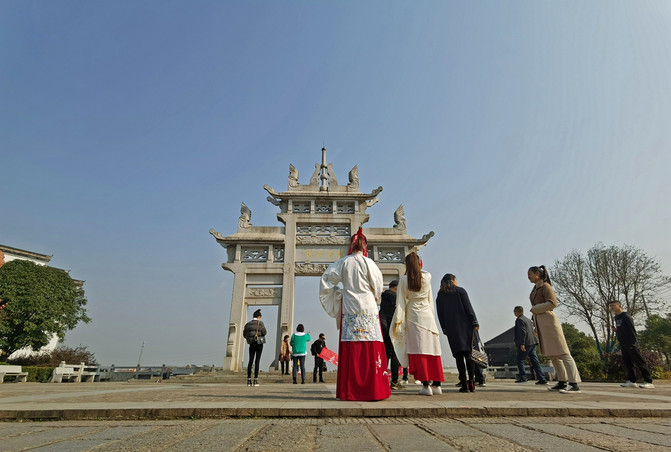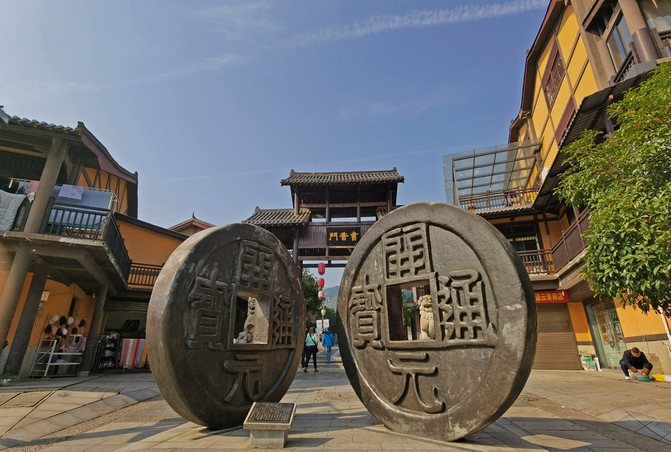Playing with porcelain and visiting brothels, the weekend in Wangcheng is so pleasant
Facing north, Xiangjiang River has a distinctive personality compared with other rivers in China. Wangcheng District is the gateway to Changsha. There are many ancient towns on both sides of the Xiangjiang River. From north to south, they are Qiaokou, Jinggang and Tongguan. Among them, Qiaokou and Jinggang are on the left bank, and Tongguan is on the right bank. These three ancient towns each have their own characteristics and can take a "weekend cultural trip".

1. Qiaokou Ancient Town, where Du Fu once wrote "Entering Qiaokou"
In ancient times, Qiaokou was a prosperous commercial town with water and land terminals. Qiaokou Old Street is also called Baishou Street, named after the 100 different characters for longevity are engraved on the Mashi road slab. The two sides of the old street are famous for their incense sticks and are still prosperous.

The Liulin River, parallel to the old street, was once the place where Du Fu went south to Huxiang and abandoned his boat and landed on the shore. Locals built a Dufu Wharf to commemorate it. "Jia Sheng's bones are rotten, and his sorrow is close to Changsha." The poet spent his last two years wandering in Huxiang, extremely poor.

In addition, Qiaokou Academy, Sanxian Temple, and Wanshou Palace are all ancient monuments. Today, Qiaokou is a fishing capital. Locals have built it into a fishing and fish eating place to attract those who pursue their appetites.

2. Jinggang Ancient Town, the last brothel
About ten kilometers south of the Xiangjiang River from Qiaokou Town, it is the ancient town of Jinggang. According to the tour guide, Jinggang Ancient Town is a national 4A-level tourist attraction, facing Weishui River in the south. Its name is related to Li Jing, a famous Tang Dynasty celebrity.

To be reliable, Jinggang should have emerged in the Ming and Qing Dynasties. It was one of the four major rice markets in Hunan and the main distribution port for Huaiyan. At that time, merchants gathered and the market was active, making it the most prosperous market town in Hunan Province.

A folk song said: "When the boat reaches Jingjiang Estuary, it will not go even if the wind is downwind." At that time, ships coming from south to north had to stop here, which shows that the wind and moon in Jinggang were the most pleasant.

Today's Jinggang Old Street still retains many old relics. Hongtaifang is a brothel site during the Qing Dynasty. It is now being turned into a museum of brothel history and civilization, recreating the scenery of the old society with luxurious decoration.

There is a replica warship in Lujiang River, which is the site of Zeng Guofan's Jinggang water battle. It is said that Zeng Guofan once fought against the Taiping Army here, but was defeated. He angrily threw himself into the river at Tongguanzhu on the other side of Jinggang. Fortunately, he was fished out, otherwise he wouldn't have been able to write a letter home.

Next door is the former site of the Hunan Provincial Committee of the Communist Party of China. It is estimated that they worked here to conceal their knowledge.

3. Tongguan Old Street, the Art of Fire and Soil
Opposite Jinggang is Tongguan Old Street, with many shops, beautiful porcelain, and the prices are relatively friendly to the people.

Tongguan Kiln is the birthplace of colorful underglaze ceramics in the world. Different from "overglaze color","underglaze colorful" is a general term for all colored porcelain that is colored below the transparent glaze layer of porcelain, such as blue and white colorful, plain triple color, etc. Colorful under craft glazing is usually fired in the kiln in one go. In the early Tang Dynasty, the "green south and white north" dominated the world. Changsha Kiln pioneered the colorful underglaze, which stood out from many famous porcelain and formed the pattern of "green south and white Changsha Color". It was praised as a "milestone in the outward expansion of Han culture" and has epoch-making significance in the history of world ceramics development.

As early as the Tang Dynasty, Changsha Tongguan Kiln products had been exported to home and abroad. Compared with the porcelain played by later officials and aristocrats, the products produced by Tongguan Kilns are more practical and people-friendly, and can be affordable to ordinary people.

The best evidence is the merchant ship Belitung that sank in the waters of Belitung Island in Indonesia. The ship set out from Guangzhou and planned to reach the Persian Gulf, but was hit by stormy waves and sank in Indonesian waters. In 1999, it was salvaged by a German, and the cultural relics on board settled in Singapore.

More than 67000 ceramic products were salvaged by the "Blackstone", 98% of which were Chinese ceramics, of which about 56500 were Changsha kiln ceramics, mainly bowls, followed by pots. The Tongguan Kiln Museum displays salvaged porcelain and a replica Arab "sewing" ship.

4. Shutang Mountain, Ouyang Xun's hometown
Shutang Mountain in Tongguan Street is considered to be the hometown of Ouyang Xun, a great calligrapher in the Tang Dynasty. Ouyang Xun is known as "the four great masters in the early Tang Dynasty" and "the first in regular script in the Tang Dynasty." The road up the mountain has now been built into a calligraphy street, with a magnificent style of writing.

The Shutang Mountain is not high, but there are cliff stone carvings written by Ouyang Xun in eight-part script style. There are still three characters clearly recognizable. There is an Ouyang Pavilion on it, with a statue of Ouyang Xun carved inside.

There is a restaurant next to Ouyang Pavilion with an elegant environment and moderate prices. It is worth recommending.

Previous Article:Encounter Dawei Mountain at 18℃! Changsha's back garden for summer vacation!
Next Article:A five-day tour of Changsha will experience the history and modern literary and artistic atmosphere of Star City.
